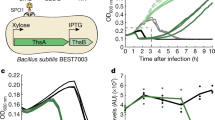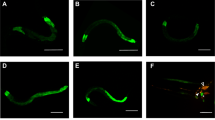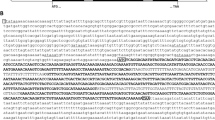Abstract
Both plants and animals respond to infection by synthesizing compounds that directly inhibit or kill invading pathogens. We report here the identification of infection-inducible antimicrobial peptides in Caenorhabditis elegans. Expression of two of these peptides, NLP-29 and NLP-31, was differentially regulated by fungal and bacterial infection and was controlled in part by tir-1, which encodes an ortholog of SARM, a Toll–interleukin 1 receptor (TIR) domain protein. Inactivation of tir-1 by RNA interference caused increased susceptibility to infection. We identify protein partners for TIR-1 and show that the small GTPase Rab1 and the f subunit of ATP synthase participate specifically in the control of antimicrobial peptide gene expression. As the activity of tir-1 was independent of the single nematode Toll-like receptor, TIR-1 may represent a component of a previously uncharacterized, but conserved, innate immune signaling pathway.
This is a preview of subscription content, access via your institution
Access options
Subscribe to this journal
Receive 12 print issues and online access
$209.00 per year
only $17.42 per issue
Buy this article
- Purchase on Springer Link
- Instant access to full article PDF
Prices may be subject to local taxes which are calculated during checkout






Similar content being viewed by others
References
Hoffmann, J.A. The immune response of Drosophila . Nature 426, 33– 38 (2003).
Khush, R.S. & Lemaitre, B. Genes that fight infection: what the Drosophila genome says about animal immunity. Trends Genet. 16, 442– 449 (2000).
Hoffmann, J.A. & Reichhart, J.M. Drosophila innate immunity: an evolutionary perspective. Nat. Immunol. 3, 121– 126 (2002).
Tzou, P., De Gregorio, E. & Lemaitre, B. How Drosophila combats microbial infection: a model to study innate immunity and host-pathogen interactions. Curr. Opin. Microbiol. 5, 102– 110 (2002).
De Gregorio, E., Spellman, P.T., Tzou, P., Rubin, G.M. & Lemaitre, B. The Toll and Imd pathways are the major regulators of the immune response in Drosophila . EMBO J. 21, 2568– 2579 (2002).
Boutros, M., Agaisse, H. & Perrimon, N. Sequential activation of signaling pathways during innate immune responses in Drosophila . Dev. Cell 3, 711– 722 (2002).
Imler, J.L. & Hoffmann, J.A. Toll receptors in Drosophila: a family of molecules regulating development and immunity. Curr. Top. Microbiol. Immunol. 270, 63– 79 (2002).
Jebanathirajah, J.A., Peri, S. & Pandey, A. Toll and interleukin-1 receptor (TIR) domain-containing proteins in plants: a genomic perspective. Trends Plant Sci. 7, 388– 391 (2002).
Bilak, H., Tauszig-Delamasure, S. & Imler, J.-L. Toll and Toll-like receptors in Drosophila . Biochem. Soc. Trans. 31, 647– 650 (2003).
Ooi, J.Y., Yagi, Y., Hu, X. & Ip, Y.T. The Drosophila Toll-9 activates a constitutive antimicrobial defense. EMBO Rep. 3, 82– 87 (2002).
Tauszig-Delamasure, S., Bilak, H., Capovilla, M., Hoffmann, J.A. & Imler, J.L. Drosophila MyD88 is required for the response to fungal and Gram-positive bacterial infections. Nat. Immunol. 3, 91– 97 (2002).
Fitzgerald, K.A. et al. Mal (MyD88-adapter-like) is required for Toll-like receptor-4 signal transduction. Nature 413, 78– 83 (2001).
Horng, T., Barton, G.M., Flavell, R.A. & Medzhitov, R. The adaptor molecule TIRAP provides signalling specificity for Toll-like receptors. Nature 420, 329– 333 (2002).
Oshiumi, H., Matsumoto, M., Funami, K., Akazawa, T. & Seya, T. TICAM-1, an adaptor molecule that participates in Toll-like receptor 3-mediated interferon-β induction. Nat. Immunol. 4, 161– 167 (2003).
Yamamoto, M. et al. Role of adaptor TRIF in the MyD88-independent toll-like receptor signaling pathway. Science 301, 640– 643 (2003).
Hoebe, K. et al. Upregulation of costimulatory molecules induced by lipopolysaccharide and double-stranded RNA occurs by Trif-dependent and Trif-independent pathways. Nat. Immunol. 4, 1223– 1229 (2003).
Yamamoto, M. et al. TRAM is specifically involved in the Toll-like receptor 4–mediated MyD88-independent signaling pathway. Nat. Immunol. 4, 1144– 1150 (2003).
Mink, M., Fogelgren, B., Olszewski, K., Maroy, P. & Csiszar, K. A novel human gene (SARM) at chromosome 17q11 encodes a protein with a SAM motif and structural similarity to Armadillo/β-catenin that is conserved in mouse, Drosophila, and Caenorhabditis elegans . Genomics 74, 234– 244 (2001).
O'Neill, L.A., Fitzgerald, K.A. & Bowie, A.G. The Toll-IL-1 receptor adaptor family grows to five members. Trends Immunol. 24, 286– 290 (2003).
Kurz, C.L. & Ewbank, J.J. Caenorhabditis elegans: an emerging genetic model for the study of innate immunity. Nat. Rev. Genet. 4, 380– 390 (2003).
Ewbank, J.J. Tackling both sides of the host-pathogen equation with Caenorhabditis elegans . Microbes and Infection 4, 247– 256 (2002).
Mallo, G.V. et al. Inducible antibacterial defence system in C. elegans . Curr. Biol. 12, 1209– 1214 (2002).
Kim, D.H. et al. A conserved p38 MAP kinase pathway in Caenorhabditis elegans innate immunity. Science 297, 623– 626 (2002).
Millet, A.C.M. & Ewbank, J.J. Immunity in Caenorhabditis elegans . Curr. Opin. Immunol. 16, 4– 9 (2004).
Jansson, H.B. Adhesion of conidia of Drechmeria coniospora to Caenorhabditis elegans wild type and mutants. J. Nematol. 26, 430– 435 (1994).
Mochii, M., Yoshida, S., Morita, K., Kohara, Y. & Ueno, N. Identification of transforming growth factor-beta- regulated genes in Caenorhabditis elegans by differential hybridization of arrayed cDNAs. Proc. Natl. Acad. Sci. USA 96, 15020– 15025 (1999).
Kurz, C.L. et al. Virulence factors of the human opportunistic pathogen Serratia marcescens identified by in vivo screening. EMBO J. 22, 1451– 1460 (2003).
Nathoo, A.N., Moeller, R.A., Westlund, B.A. & Hart, A.C. Identification of neuropeptide-like protein gene families in Caenorhabditis elegans and other species. Proc. Natl. Acad. Sci. USA 98, 14000– 14005 (2001).
Ehret-Sabatier, L. et al. Characterization of novel cysteine-rich antimicrobial peptides from scorpion blood. J. Biol. Chem. 271, 29537– 29544 (1996).
Kato, Y. et al. abf-1 and abf-2, ASABF-type antimicrobial peptide genes in Caenorhabditis elegans . Biochem. J. 361, 221– 230 (2002).
Lemaitre, B., Nicolas, E., Michaut, L., Reichhart, J.M. & Hoffmann, J.A. The dorsoventral regulatory gene cassette spatzle/Toll/cactus controls the potent antifungal response in Drosophila adults. Cell 86, 973– 983 (1996).
Pujol, N. et al. A reverse genetic analysis of components of the Toll signalling pathway in Caenorhabditis elegans . Curr. Biol. 11, 809– 821 (2001).
Beutler, B. & Rehli, M. Evolution of the TIR, tolls and TLRs: functional inferences from computational biology. Curr. Top. Microbiol. Immunol. 270, 1– 21 (2002).
Harris, T.W. et al. WormBase: a cross-species database for comparative genomics. Nucleic Acids Res. 31, 133– 137 (2003).
Timmons, L. & Fire, A. Specific interference by ingested dsRNA. Nature 395, 854 (1998).
Kamath, R.S. et al. Systematic functional analysis of the Caenorhabditis elegans genome using RNAi. Nature 421, 231– 237 (2003).
Lambert, R.W., Campton, K., Ding, W., Ozawa, H. & Granstein, R.D. Langerhans cell expression of neuropeptide Y and peptide YY. Neuropeptides 36, 246– 251 (2002).
Vouldoukis, I., Shai, Y., Nicolas, P. & Mor, A. Broad spectrum antibiotic activity of the skin-PYY. FEBS Lett. 380, 237– 240 (1996).
Metz-Boutigue, M.H., Kieffer, A.E., Goumon, Y. & Aunis, D. Innate immunity: involvement of new neuropeptides. Trends Microbiol. 11, 585– 592 (2003).
Tzou, P., Reichhart, J.M. & Lemaitre, B. Constitutive expression of a single antimicrobial peptide can restore wild-type resistance to infection in immunodeficient Drosophila mutants. Proc. Natl. Acad. Sci. USA 99, 2152– 2157 (2002).
Nielsen, H., Engelbrecht, J., Brunak, S. & von Heijne, G. A neural network method for identification of prokaryotic and eukaryotic signal peptides and prediction of their cleavage sites. Int. J. Neural Syst. 8, 581– 599 (1997).
Mello, C.C., Kramer, J.M., Stinchcomb, D. & Ambros, V. Efficient gene transfer in C. elegans: extrachromosomal maintenance and integration of transforming sequences. EMBO J. 10, 3959– 3970 (1991).
Bertucci, F. et al. Sensitivity issues in DNA array-based expression measurements and performance of nylon microarrays for small samples. Hum. Mol. Genet. 8, 1715– 1722 (1999).
Kamath, R.S., Martinez-Campos, M., Zipperlen, P., Fraser, A.G. & Ahringer, J. Effectiveness of specific RNA-mediated interference through ingested double-stranded RNA in Caenorhabditis elegans . Genome Biol. 2, research 0002.1– 0002.10 (2001).
Walhout, A.J. et al. Protein interaction mapping in C. elegans using proteins involved in vulval development. Science 287, 116– 122 (2000).
Reboul, J. et al. C. elegans ORFeome version 1.1: experimental verification of the genome annotation and resource for proteome-scale protein expression. Nat. Genet. 34, 35– 41 (2003).
Vaglio, P. et al. WorfDB: the Caenorhabditis elegans ORFeome Database. Nucleic Acids Res. 31, 237– 240 (2003).
Acknowledgements
Some strains were provided by the Caenorhabditis Genetics Center, which is funded by the National Institutes of Health National Center for Research Resources. Certain RNAi bacterial strains were from the Ahringer library provided by MRC geneservice. Mass spectroscopy was done with the facilities of the Proteomic Platform of the Montpellier-Languedoc-Roussillon genopole, microarray, and worm sorting analyses, with those of the Transcriptome and C. elegans functional genomics Platforms of the Marseille-Nice genopole. We thank A. Blanc and N. O'Neill for advice on sorting; J.-L. Bessereau, A. Fire and A. Hart for the gift of vectors; A. Coulson and the Worm Genome Research Consortium for providing the clones and sequences that made this work possible; H.-B. Jansson for the gift of drechmeria; S. Granjeaud and B. Loriod for assistance with the microarray experiments; E. De Gregorio, C. Hetru, J.L. Imler and L. Troxler for communicating results before publication and/or discussion; and P. Golstein and T. Lecuit for critical reading of the manuscript. Supported by institutional grants from the Centre National de la Recherche Scientifique and Institut National de la Santé et de la Recherche Médicale, Ministry of Research (Programme de Recherche Fondamentale en Microbiologie et Maladies Infectieuses et Parasitaires and Action Concertée Incitative-Biologie du Développement et Physiologie Intégrative) and Centre National de la Recherche Scientifique (Actions Thématiques et Incitatives sur Programme et Equipes) grants to J.J.E.
Author information
Authors and Affiliations
Corresponding author
Ethics declarations
Competing interests
The authors declare no competing financial interests.
Supplementary information
Rights and permissions
About this article
Cite this article
Couillault, C., Pujol, N., Reboul, J. et al. TLR-independent control of innate immunity in Caenorhabditis elegans by the TIR domain adaptor protein TIR-1, an ortholog of human SARM. Nat Immunol 5, 488–494 (2004). https://doi.org/10.1038/ni1060
Received:
Accepted:
Published:
Issue Date:
DOI: https://doi.org/10.1038/ni1060
This article is cited by
-
Paeoniflorin increases the survival of Pseudomonas aeruginosa infected Caenorhabditis elegans at the immunosuppression stage by activating PMK-1, BAR-1, and EGL-1 signals
Archives of Pharmacal Research (2023)
-
Characterization of the novel temperate Staphylococcus haemolyticus phage IME1365_01
Archives of Virology (2023)
-
Caenorhabditis elegans DAF-16 regulates lifespan and immune responses to Cryptococcus neoformans and Cryptococcus gattii infections
BMC Microbiology (2022)
-
Lacticaseibacillus rhamnosus Probio-M9 extends the lifespan of Caenorhabditis elegans
Communications Biology (2022)
-
C. elegans: out on an evolutionary limb
Immunogenetics (2022)



